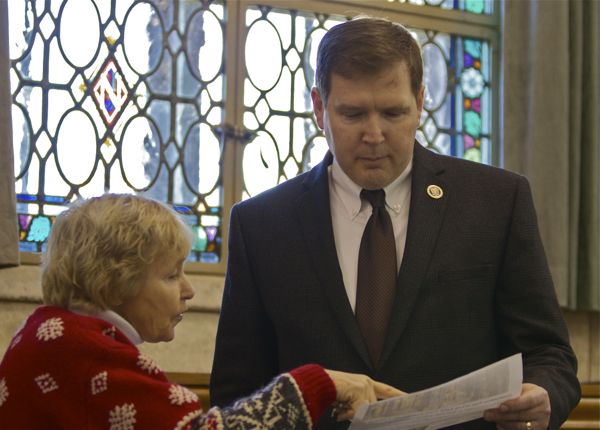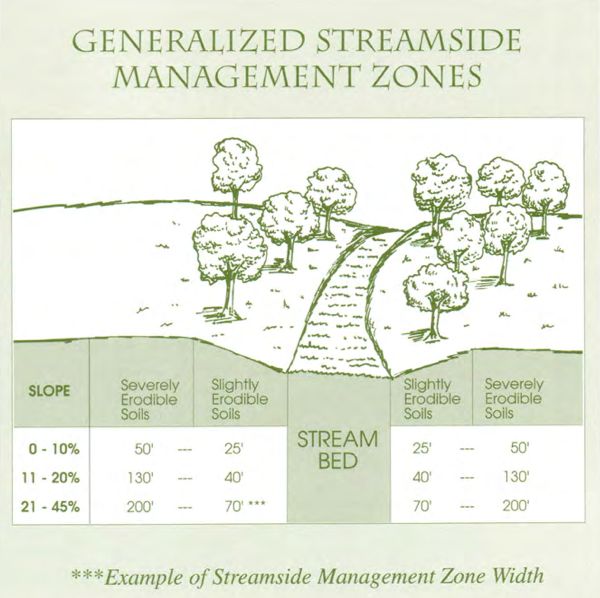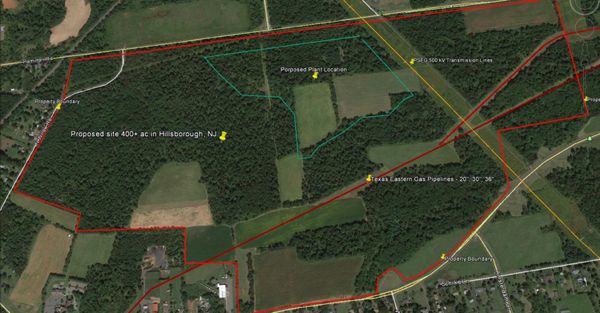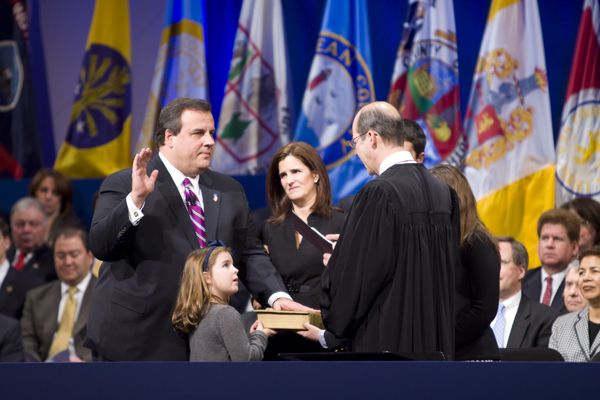Loopholes In Wetlands, Stream Buffers, Habitat, Steep Slopes & Erosion Protections
Local governments are prohibited from conducting reviews
(this is part three of our look at the DEP’s proposed Sparta Mountain “Forest Stewardship Plan” which would significantly expand logging on the mountain. Here are links to read part one and part two).

Senator Doherty (R/Hunterdon) listens to former Mayor of Readington Twshp about forestry abuses (12/9/11)
If “forest stewardship” is such a good thing, ask yourself these five questions:
1) Why are local governments and residents banned from reviewing and regulating a Forest Stewardship Plan under local land use ordinances?
I doubt that local officials or residents are aware that the Legislature stripped their powers in a 2009 law that established a “Forest Stewardship” program for private lands.
Section 6 of P.L. 2009, c. 256 provides:
6. No local government unit may enact, on or after the date of enactment of P.L.2009, c.256 (C.13:1L-29 et al.), any ordinance, rule, or resolution, as appropriate, that conflicts with, prevents or impedes the implementation of a forest stewardship plan approved pursuant to section 3 of P.L.2009, c.256 (C.13:1L-31) or impose a fee in excess of $100 in any calendar year for the cutting of trees on any land that is the subject of an approved forest stewardship plan. The provisions of P.L.2009, c.256 (C.13:1L-29 et al.) supersede any such ordinance, rule, or resolution, as appropriate, enacted or adopted on or prior to the date of enactment of P.L.2009, c.256 (C.13:1L-29 et al.).
The bill was signed into law by Governor Corzine on his last day in office.
While the law was intended to apply to private lands, the prohibition on local review is tied to “a DEP approved forest stewardship plan”. So I read that as applying to the Sparta Mountain Forest Stewardship Plan currently pending approval by DEP.
2) Why did the Legislature exempt “forest stewardship” from the Highlands Act and RMP (but not the Pinelands Act and CMP)?
The same 2009 law amended Section 30 of the 2004 Highlands Act to expand greatly the original exemption for a “woodland management plan” to provide an exemption for “forest stewardship” from the Highlands Act (see lines 16 – 18 on page 11)
30. a. The following are exempt from the provisions of this act, the regional master plan, any rules or regulations adopted by the Department of Environmental Protection pursuant to this act, or any amendments to a master plan, development regulations, or other regulations adopted by a local government unit to specifically conform them with the regional master plan:
[(1) – (6)]
(7) an activity conducted in accordance with an approved woodland management plan pursuant to section 3 of P.L.1964, c.48 (C.54:4-23.3) or a forest stewardship plan approved pursuant to section 3 of P.L.2009, c.256 (C.13:1L-31), or the normal harvesting of forest products in accordance with a forest management plan or forest stewardship plan approved by the State Forester;
In contrast, the law requires compliance with the Pinelands CMP: (see Statement, page 2)
Forest stewardship plans submitted for land in the pinelands area must be consistent with the standards in the comprehensive management plan for such areas.
Why are the Highlands forests given less protection than the Pinelands forests?
The Highlands Act was based in part on the Pinelands Act, so that makes no sense.
The only reason I can think of to explain this loophole is to exploit the value of hardwood timber from Highlands forests and bypass aggressive Highlands advocates.
3) Why has DEP failed to create a Forest Stewardship Council and strict standards and regulations mandated by a 2009 law?
It is seven years since passage of the 2009 law, yet DEP has failed to comply with the law and establish science based standards and a public review process for preparing Forest Stewardship plans.
The law requires: (see Statement, page 3)
The bill directs the DEP, in consultation with the forest stewardship advisory committee, which is to be established by the DEP pursuant to this bill, and using guidance provided by the United States Forest Service, to develop and establish forest sustainability criteria and indicators specific to New Jersey in order to record, assess, and monitor the sustainability, condition, and extent of New Jersey forests. The DEP must prepare a report every seven years with findings based on the forest sustainability criteria and indicators, with the first report due by February 1st of the third year following the date of enactment of the bill.
The bill also authorizes the DEP to adopt rules and regulations to: set forth policies, guidelines and best management practices that establish standards designed to ensure the sustainability of forest lands; establish a forest stewardship advisory committee; and implement the bill.
4) Why is “forest stewardship” exempt from environmental laws and regulations?
The DEP Sparta Mountain logging plan will have significant impacts on wetlands, Russia Brook, a Category One trout production stream, vernal ponds, lakes, groundwater, wildlife habitat, plants, and ecosystems, and steep slopes.
The standards in the DEP plan are woefully inadequate – for example, the Russia Brook is a trout production C1 stream protected by 300 foot wide buffers. Trout are a cold water species that is extremely sensitive to stream temperature and sedimentation destroys their habitat.
Yet, look at how grossly inadequate the DEP plan is: (see page 13)
- Selection method harvesting had no obvious effect on watershed stream temperatures. In clear-cuts where no vegetated buffer was maintained along streams, stream temperatures generally were a few degrees higher during the growing season and a few degrees lower during the dormant season, but returned to pretreatment levels with 3-5 years. When a 50- foot-wide buffer strip was maintained, clear-cutting had no effect on stream temperature. This would imply that subsurface groundwater down-slope of a clear-cut treatment with a vegetated buffer would also maintain a stable, pre-harvest temperature.
Similarly, sensitive ponds drained by steep slopes get just 40 foot wide buffers: (see page 14)
Ponds
- Collins Pond: Located in the southwestern portion of the WMA just east of Hawthorne Lake Road, directly underneath the PSE&G Utility ROW. Surrounding slopes range between 11-20 percent, requiring a minimum 40 foot SMZ.
- Edison Pond: Located in the southeastern portion of the WMA less than 0.1 miles east of Edison Road. The pond is a manmade product of mining, and is located near the Edison Monument. Surrounding slopes range between 0-10 percent, requiring a minimum of 25 foot SMZ.
- Ryker Lake: Located in the southeastern corner of the WMA directly north of Glen Road, with access from Edison Road. The lake is categorized as a bass and perch conservation lake by NJDFW. The surrounding slopes range from 0-20 percent, requiring a minimum 40 foot SMZ.
Even exceptional value wetlands that support rare or endangered species habitat are provided just a 100 foot buffer and rare plants, just 50 foot buffers: (see page 22)
2. Wetlands:
- A 100-foot forested buffer from all wetlands as well as a minimum 50-foot undisturbed vegetated buffer between all rare plants (S1-S3) and intense management activities will be retained.
There are effectively no steep slope protections, despite the fact that disturbance of steep slopes is strictly prohibited under the Highlands Act.
Similarly, soil erosion and sediment control requirements are not adequately protective.
Logging is a very destructive activity.
At a minimum, DEP should have adopted new regulations that apply to forestry in the wake of passage of the Highlands Act and the Category One (C1) Waters anti-degradation policy and 300 foot buffer program.
This is insane.
5) Why is “forest stewardship” subject only to a 20 year old and voluntary “Wetlands Best Management Practices Manual” adopted by the Whitman DEP way back in 1995?
The DEP logging plan relies on a DEP Wetlands BMP manual to protect wetlands and “riparian areas”:
- Protect and enhance hydrologic resources – Adhere to NJ Forestry and Wetlands BMP Manual when managing in and around riparian areas.
So, I Googled around to read that Wetlands BMP Manual – and immediately noted that is was adopted over 20 years ago, in 1995, during the Whitman Administration.
The 1995 adoption of this BMP Manual preceded the 2002 Category One 300 foot buffer initiative and the 2004 Highlands Act, which imposed strict new regulatory standards to protect water resources, forests, habitat, steep slopes and scenic and recreational values.
For example, all Highlands waters are protected by 300 foot buffers.
C1 stream buffers are a BMP to protect water quality and despite the fact that they are not legally applicable to forestry activities, technically they should supersede the 1995 wetlands BMPs.
The Wetlands BMP manual is completely out of date and needs to be updated to reflect new science and current regulatory policies for Highlands forests and C1 waters. It is so flawed that it can not be relied upon.
At a minimum, DEP should have updated the BMP Manual in response to the Highlands Act and the Category One (C1) Waters program. Obviously, the BMP manual is outdated and deeply flawed and should be revoked and promulgated as an enforceable regulation with regulatory standards.
I then noted that forestry is exempt from the permit requirements of the Freshwater Wetlands Act. Check out the BMP Manual spins that exemption:
How to protect NJ’s wetlands while practicing forestry activities is an integral part of this manual. Under the 1987 NJ Freshwater Wetlands Protection Act, normal harvesting of cores products in accordance with a Forest Management Plan approved by the State Forester is exempt from the requirement of wetland permit. The plan must meet the minimum standards necessary for protecting and maintaining NJ’s forested wetlands and as well as the quality of the surface waters within these wetlands.
DEP scientists and DEP regulators have found that 300 foot wide buffers are required to protect C1 stream and trout production waters, and that 150 transition areas are required to protect exceptional value wetlands.
So how can DEP possibly approve the lack of buffers and the tiny 40 – 500 foot wide buffers in the proposed logging plan? And no mitigation requirements either.
The Wetlands BMP Manual also includes “Streamside Management Zone” (SMZ) measures to protect water quality from logging activities.
The SMZ in the BMP manual is totally inadequate – it calls for buffers of just 25 – 50 feet.
Even in forests with highly erodible soils on slopes of more than 20 percent, the BMP manual recommends just 130 foot wide buffers!
Aside from these egregious technical flaws, the BMP manual is not enforceable as a regulatory standard and the public had no opportunity to participate in their development.
More to follow in part 4.

Source: NJ DEP Wetlands BMP Manual







